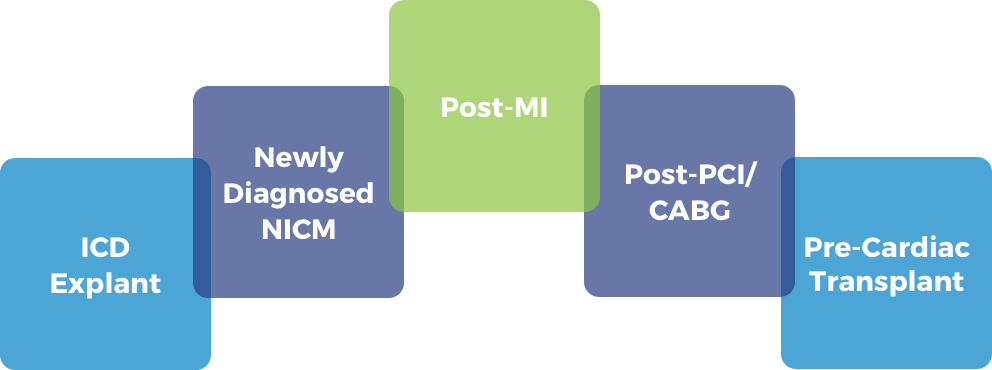Prescribe the LifeVest

The 2017 AHA/ACC/HRS Guidelines include recommended use of the WCD for a wide range of patients at risk of sudden cardiac death (SCD).6
Click below to review the recommendations:
ICD Explant
In patients with an ICD and a history of SCA or sustained VA [ventricular arrhythmia] in whom removal of the ICD is required (as with infection), the wearable cardioverter-defibrillator is reasonable for the prevention of SCD.Class IIa; Level of Evidence B-NR
Newly Diagnosed NICM
In patients at an increased risk of SCD but who are not ineligible for an ICD, such as awaiting cardiac transplant, having an LVEF of 35% or less and are within 40 days from an MI, or have newly diagnosed NICM, revascularization within the past 90 days, myocarditis or secondary cardiomyopathy or a systemic infection, wearable cardioverter-defibrillator may be reasonable.Class IIb; Level of Evidence B-NR
Post-MI
In patients at an increased risk of SCD but who are not ineligible for an ICD, such as awaiting cardiac transplant, having an LVEF of 35% or less and are within 40 days from an MI, or have newly diagnosed NICM, revascularization within the past 90 days, myocarditis or secondary cardiomyopathy or a systemic infection, wearable cardioverter-defibrillator may be reasonable.Class IIb; Level of Evidence B-NR
Post-PCI/CABG
In patients at an increased risk of SCD but who are not ineligible for an ICD, such as awaiting cardiac transplant, having an LVEF of 35% or less and are within 40 days from an MI, or have newly diagnosed NICM, revascularization within the past 90 days, myocarditis or secondary cardiomyopathy or a systemic infection, wearable cardioverter-defibrillator may be reasonable.Class IIb; Level of Evidence B-NR
Pre-Cardiac Transplant
In patients at an increased risk of SCD but who are not ineligible for an ICD, such as awaiting cardiac transplant, having an LVEF of 35% or less and are within 40 days from an MI, or have newly diagnosed NICM, revascularization within the past 90 days, myocarditis or secondary cardiomyopathy or a systemic infection, wearable cardioverter-defibrillator may be reasonable.Class IIb; Level of Evidence B-NR
Inclusion of the WCD in these guidelines is a call to action for clinicians to identify all patients who are indicated for the therapy. By setting this standard in our practices and institutions, we can ensure that all indicated patients are protected during the period of highest SCD risk while we determine their best long-term care plan.



